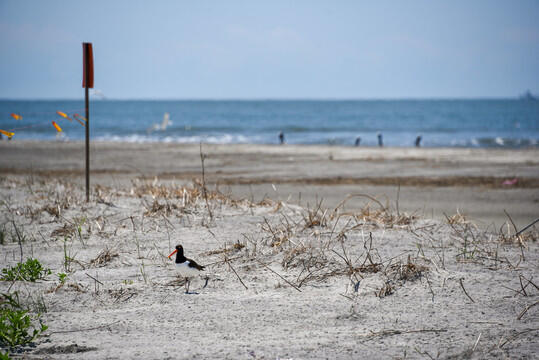CHARLESTON COUNTY, S.C. (Mar. 30, 2022) – The well-camouflaged nest was barely visible to the untrained eye – just a pair of speckled eggs in a sandy divot – but South Carolina Department of Natural Resources (SCDNR) biologist Janet Thibault knew she was looking at the first documented shorebird nest of the season.
Nesting season has begun for South Carolina’s coastal birds, kicked off last week by the oystercatcher nest Thibault located on Crab Bank Seabird Sanctuary in Charleston Harbor. State officials are reminding beachgoers to help protect these special birds by giving them space on the islands and beaches where they feed, rest and nest.
Ranging in size from brown pelicans to tiny Wilson’s plovers, roughly a dozen shorebird and seabird species nest on South Carolina’s beaches and islands. Seabirds nest in large, bustling colonies that can number hundreds of thousands of birds, while shorebirds are solitary nesters.
Breeding and nesting season span roughly from March 15 to October 15 of every year. Coastal birds need safe, undisturbed spaces in which to successfully nest and raise their chicks during this time, so SCDNR biologists use posts and signage to rope off suitable habitat each year. Coastal bird species have declined 70% in the last 40 years, making such protections necessary to the survival of these species in South Carolina.
SCDNR protects a handful of ephemeral islands along the coast known as Seabird Sanctuaries, including Crab Bank, Bird Key-Stono and Deveaux Bank. These islands host large nesting colonies or seabirds such as brown pelicans, black skimmers, royal terns and others, and they're closed to all landing from March 15 to October 15 (with the exception of some parts of Deveaux Bank).
Other SCDNR-managed barrier islands have regulations in place to protect not only beach-nesting birds but also other wildlife such as sea turtles. Regulations for these properties are available online here.
Tips for Beachgoers
SCDNR officials urge beachgoers to contribute to a successful nesting season by following these tips when visiting the beach:
- Familiarize yourself with local regulations before heading to the beach.
- Leave dogs at home or, where allowed, keep them on a short leash. Coastal birds perceive all dogs as predators; even the presence of well-behaved pups can stress nesting parents and cause them to flee.
- Avoid roped-off nesting areas. When parents are forced to fly off the nest, they leave eggs and chicks vulnerable to the heat of summer and other predators.
- Leave only footprints. Take personal items, trash, and food scraps that you may have brought with you so as not to attract predators such raccoons and laughing gulls.
- Walk around birds, not through them. Walk in the wet sand and around birds that may be feeding by the shoreline.








